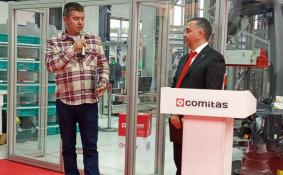Scientific & Practical Journal

Editorial News
Dear readers! We are pleased to present to you the eleventh issue of the journal in 2025. There are a lot of relevant and useful materials in the issue, which, hopefully, will not be ignored.
Dear readers! In September the CeMAT RUSSIA exhibition was held, which showed everyone that innovations and robotics are increasingly penetrating the logistics industry. We can safely say that many technologies are tested here, and only then they go out into the world. However, it is not only CeMAT RUSSIA that demonstrates the prevalence of the digital agenda.
Dear readers! This is the ninth issue of the journal, which turned out to be very rich and diverse. Traditionally, the issue is opened by an analyst. The material by Alina Nasyrova from the Market Guide Agency, dedicated to investments in warehouse complexes in Russia, recalls the importance of developing logistics infrastructure for the integrated development of regions.
PHOTO OF THE WEEK
CITATIONS
All News of Logistics
DB Schenker suggests three-dimensional printing of spare automobile parts as an alternative to conventional delivery
DB Schenker is the first logistics operator in the world that provides a wide range of 3D printing services to its customers. The order may be registered through the on-line platform e-Schenker. By means of this electronic resource, the client can choose the necessary materials, get an access to the price list, place the order and obtain ready- made products.
Analyst`s reports point at the fact that the volume of European 3D-printing market in 2018 approximately amounted to 4 billion dollars. However, there is no doubt that the tendency will not change and the upcoming years will register stable growth within the above-mentioned industry brunch. Finally, in 2020 the total volume of 3D-printing market is about to reach 5 billion dollars and in 2020 will go beyond 7 billion dollars.
The figures reflecting the development of the same market sector in Russia seem less impressive. Last year the total volume of 3D printing market has hardly exceeded 2 billion rubles. CEO of JSC Schenker, Aivars Taurins, states that additive manufacturing in western countries is way ahead of that in Russia. This state of affairs is determined by high prices for equipment that should be imported into Russia from abroad for manufacturing purposes. Nevertheless, Mr. Taurins believes that the industry has a window of opportunities as the demand on 3D-printing services has already exceeded the supply.
Nowadays the head office of DB Shenker in Germany suggests printing of automobile spare parts, stainless steel medical equipment, plastic finger-grippers for robots and packing materials for individual orders. Among the materials used in 3D printing are aluminum, stainless steel, plastic, titanium and other alloys.
3D printing technology guarantees relocating of goods manufacturing closer to the potential customers, thus, facilitating transportation processes. Amazon has already filed a number of patent applications, which will allow its customers to see that the goods they need are manufactured literally next door. Thanks to patented mobile production facilities, delivery-drivers will be able to manufacture goods right in the delivery vans. This scheme will significantly reduce the delivery time together with the demand on warehouse spaces. Aivars Taurins also made a remark that DB Schenker regards launching of 3D printing as an alternative to goods shipping. New technologies will create new advantages for our clients.
Nowadays DB Schenker has not launched 3D printing in Russia yet as the company does not possesses its own 3D printers. That is why it makes use of the resources provided by the European partners, however, the situation is about to change in the near future. If the company sticks to the plan, 3D manufacturing project will spread its roots on the Russian territory in 2019.












